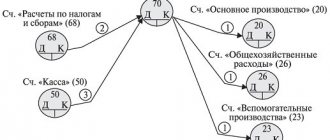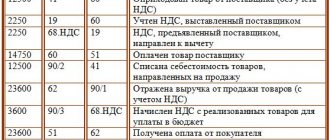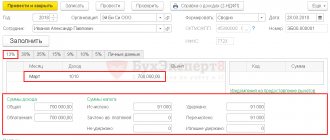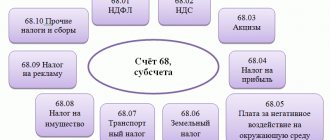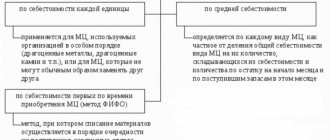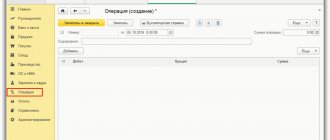The accrual of taxes and their payment is reflected in account 68 “Calculations for taxes and fees”. For more convenient accounting, account 68 is divided into several sub-accounts, each of which takes into account different taxes. Such a division will make accounting more transparent and make it clear which tax is owed to the budget, and which tax the organization owes. Similarly, account 69 “Calculations for social insurance and security” is divided into subaccounts. In the article we will talk about the features of accounting for account 68, and also consider typical transactions and examples of transactions with taxes and fees.
Count 68: features of use
Account 68 is used to reflect transactions for the calculation and transfer of taxes and fees that the organization pays to the budget of the federal and regional levels. As a rule, in account 68, enterprises post the amounts of obligations for value added tax (VAT), income tax (INP), property tax, etc.
The accrual of tax amounts is reflected in K68; when transferring funds to the budget and when accepting tax for deduction, D68 is used.
Let's look at typical wiring:
| Debit | Credit | Description | Document |
| 68 | 19 | The tax amount is written off as a credit (for the purchase of goods, services, works) | Consignment note, act |
| 68 | 50, 51, 55 | The tax amount is transferred to the budget | Payment order, cash order |
| 10, 15 | 68 | Inclusion in the cost of materials (stocks) is the amount of non-refundable tax | Packing list |
| 20, 23, 29 | 68 | The amount of accrued tax is taken into account in production expenses | Acts, invoices, limit-fence cards |
| 44 | 68 | Accrued tax is included in sales expenses | Acts, invoices, expense reports |
How to pay off debt - correspondence of invoices and postings
For more detailed accounting, this account is divided into subaccounts for specific taxes. Penalties and fines for non-payment are also taken into account here.
In this case, there is no difference whether the organization pays taxes for itself or acts as a tax agent (for example, transfers personal income tax for its employees). Any payables for tax payments are reflected in this account.
This account corresponds by debit with the following accounts:
- 19 — VAT on purchased valuable goods;
- 50 - cash register;
- 51 (52) - current (currency) account;
- 55 - special bank account;
- 66 (67) - calculations for loans and credits (short- and long-term).
For the loan, the account corresponds with the following positions:
- 08 - investments in non-current assets (funds);
- 10 - materials;
- 11 - animals being fattened and raised;
- 15 — purchase (procurement) of material assets;
- 20 (23) - main (auxiliary) production;
- 26 — expenses for general economic needs;
- 29 - service industries;
- 41 - goods;
- 44 - sales expenses;
- 51 (52) - current (currency) account;
- 55 - special bank account;
- 70 (75) - settlements with employees for wages (with founders for income paid to them);
- 90 - sales;
- 91 - other income and expenses;
- 98 - future income;
- 99 - profit and loss.
Payment of taxes and fees is reflected in active-passive account No. 68.
Accounting for individual taxes and fees
Let us consider (without specifying details and all possible cases) the main entries used in accounting for transactions related to the calculation of taxes and their payment to the budget.
Federal taxes
- VAT . The need to pay it arises when selling goods, works, services produced (rendered) by the enterprise, or when selling other property. Therefore, basically account 68 for VAT is associated with accounts 90 and 91, respectively, and, like all other taxes, with accounts 50, 51 and 52, which account for cash. In addition, VAT can be deducted (refunded from the budget) when purchasing necessary products from suppliers, the price of which includes this tax. To account for such situations, the posting is made with the account 19. VAT accounting is quite complicated. All postings will not be given in this article. It should only be noted that to record it for purchased materials and other goods, which are then presented for deduction, entries with accounts 20, 23, 29 and others are first used.
| Postings | Explanations |
| D 90 (91) K 68 | VAT is charged on the sale of products of your own production (sale of your property) |
| K 68 D 19 | VAT is subject to deduction |
| D 68 K 51 | VAT is paid to the budget |
- Income tax . It is paid from profit, accrued on its amount and the amount of other income, therefore accounts 99, 91 are used.
| Postings | Explanations |
| D 99 (91) K 68 | It is accrued from profits from sales (from other income, for example, from funds and property received free of charge) |
| D 68 K 51 (52) | It is paid to the budget |
- Personal income tax . It is paid from the income of employees, therefore it corresponds to the account 70.
| Postings | Explanations |
| D 70 K 68 | Personal income tax is charged |
| D 68 K 51 | Payment is being made |
Other taxes and fees
- Property tax . It is paid from pre-tax profits. Therefore, it is taken into account “in conjunction” with a score of 91.
| Postings | Explanations |
| D 91 K 68 | It is being accrued |
| D 68 K 51 | Payment is being made (accounts payable are repaid) |
- Land tax . Its amount (and the amount of debt) depends on the cadastral value of the land. The latter, in turn, follows from the location and purpose of the site. Therefore, when accounting for this tax, along with account 68, accounts are used that take into account the costs incurred on such lands. For example, for agricultural organizations - with a score of 20. If the land is not used in the main and auxiliary production, the posting is made with a score of 91.
| Postings | Explanations |
| D 20 (23, 91) K 68 | Tax is being calculated |
| D 68 K 51 | It is paid to the budget |
- State duty . It is transferred to the budget for various operations, for example, for registering ownership of fixed assets, considering a case in an arbitration court, and notarial acts. This “creditor” is also accounted for on account 68, in conjunction with accounts 91 (court fee, for notarization) and 08 (for the acquisition of non-current assets in the form of a certificate of ownership).
| Postings | Explanations |
| D 08 (91) K 68 | Duty is charged |
| D 68 K 50 (51) | It is included in the budget |
- Sanctions for incomplete or late payment of taxes.
| Postings | Explanations |
| D 99 K 68 | Fines and penalties accrued |
| D 68 K 51 | The “creditor” under sanctions has been repaid |
Thus, the main points on such a phenomenon as accounts payable for taxes and fees are considered.
In conclusion, it should be noted that when acknowledging, claiming or paying any debt, be it accounts payable or receivable, to legal entities or individuals, its painstaking accounting and correct documentation is very important. And this is a matter for lawyers and financiers.
Happy cooperation!
Video lesson: Account 68 in accounting.
Video lesson on basic operations on accounting account 68, key entries, practical examples. The lesson is taught by consultant and expert of the “Accounting for Dummies” website, chief accountant N.V. Gandeva. ⇓
You can download the presentation for the video lesson from the link below.
Download the presentation “Account 68 in accounting” in PDF format
| Buy ★ bestselling book “Accounting from scratch” for dummies (understand how to do accounting in 72 hours) > 8000 books purchased |
Reflection of transactions with VAT
Depending on the type of activity, an enterprise can carry out various VAT transactions. We will consider the main such operations using examples.
VAT when making a contribution to the authorized capital of another organization
In January 2021, Yantar JSC purchased from Rubin LLC a batch of construction and repair materials worth 48,350 rubles, VAT 7,375 rubles. In March 2021, Yantar JSC acquired a stake in the authorized capital of Amethyst JSC. The cost of the share is 54,280 rubles. Construction materials previously purchased from Rubin LLC were transferred to pay off the debt on the contribution to the authorized capital of Amethyst JSC.
These transactions were reflected in the accounting of Yantar JSC with the following entries:
| Debit | Credit | Description | Sum | Document |
| 10 | 60 | Construction materials purchased from Rubin LLC have been received (RUB 48,350 – RUB 7,375) | RUB 40,975 | Packing list |
| 19 | 60 | The amount of VAT on purchased building materials is reflected | RUR 7,375 | Invoice |
| 68 VAT | 19 | VAT on the cost of building materials is accepted for deduction | RUR 7,375 | Invoice |
| 58 | 76 | The acquisition of a stake in Amethyst JSC was taken into account | RUR 54,280 | Contract of sale |
| 76 | 10 | Reflected the transfer of construction materials to pay off the debt on the contribution to the authorized capital of Amethyst JSC | RUB 40,975 | Transfer and Acceptance Certificate |
| 19 | 68 VAT | The amount of VAT on purchased building materials, previously accepted for deduction, has been restored | RUR 7,375 | Certificate of acceptance and transfer of construction materials, Invoice |
| 58 | 19 | The amount of VAT recovered when making a contribution to the authorized capital of “Amethyst” is taken into account | RUR 7,375 | Certificate of acceptance and transfer of construction materials, Invoice |
| 76 | 91.1 | The amount of income from the transfer of building materials is taken into account (RUB 54,280 – RUB 40,975) | RUB 13,305 | Certificate of acceptance and transfer of construction materials, Invoice |
| 68 Income tax | 99 PNO | The amount of permanent tax asset is taken into account (RUB 13,305 * 20%) | RUB 2,661 | Accounting certificate-calculation |
VAT on sales of goods
In April 2015, JSC Everest sold LLC Kazbek a batch of goods - 12 inflatable boats for fishing:
- selling price of one boat – 94,350 rubles, VAT 14,392 rubles;
- unit cost of goods – 73,150 rubles.
The accountant of Everest JSC reflected these transactions with the following entries:
| Debit | Credit | Description | Sum | Document |
| 45 | 43 | The cost of a batch of boats sold by Kazbek LLC was taken into account (RUB 73,150 * 12 units) | 877.800 rub. | Costing |
| 76 | 68 VAT | The amount of VAT is reflected on the cost of sales (RUB 14,392 * 12 units) | RUB 172,704 | Invoice |
| 51 | 62 | Funds have been credited from Kazbek LLC as payment for a batch of inflatable boats (RUB 94,350 * 12 units) | 1,132,200 rub. | Bank statement |
| 62 | 90.1 | The amount of revenue from the sale of boats is taken into account | 1,132,200 rub. | Packing list |
| 90.2 | 45 | The cost of boats sold is written off as expenses | 877.800 rub. | Costing |
| 90.3 | 76 | The amount of VAT on revenue is taken into account | RUB 172,704 | Invoice |
VAT on the amount of advances received
An agreement was concluded between JSC Stimul and LLC Rubikon for the supply of cabinet furniture worth RUB 1,143,850, VAT RUB 174,486. On January 12, 2016, the supplier JSC Stimul received an advance payment in the amount of 100% of the cost of furniture delivery. On January 15, 2016, furniture was shipped from the warehouse of Stimul JSC to Rubicon LLC.
In the accounting of Stimul JSC, the accountant made the following entries:
| Debit | Credit | Description | Sum | Document |
| 51 | 62.2 | Funds have been credited from Rubikon LLC as an advance payment for the supply of cabinet furniture | RUB 1,143,850 | Bank statement |
| 76 Advances received | 68 VAT | The amount of VAT on the prepayment received is taken into account | RUR 174,486 | Invoice |
| 62.1 | 90.1 | Furniture was shipped from the warehouse of Stimul JSC to Rubikon LLC. | RUR 174,486 | Packing list |
| 90.3 | 68 VAT | The amount of tax on the sale of furniture is reflected | RUR 174,486 | Invoice |
| 62.2 | 62.1 | The repayment of the debt of Rubicon LLC with the previously transferred advance is reflected | RUB 1,143,850 | Bank statement, delivery note |
| 68 VAT | 76 Advances received | The VAT amount is accepted for deduction | RUR 174,486 | Invoice |
VAT upon termination of the contract
In June 2015, JSC Europe entered into an agreement with LLC Asia to carry out work to repair the production line of workshop No. 2. The cost of the work (327,350 rubles, VAT 49,934 rubles) was transferred as an advance to the bank account of Asia LLC. In August 2015, the contract with Asia LLC was terminated, the work was not completed, and the funds were returned to the account of JSC Europe.
When recording transactions, the accountant of Asia LLC made the following entries:
| Debit | Credit | Description | Sum | Document |
| 51 | 62 Advances received | Funds have been credited as an advance payment from JSC Europe for the repair of the production line of workshop No. 3 | RUR 327,350 | Bank statement |
| 62 Advances received | 68 VAT | The amount of VAT accrued on the advance received from JSC “Europe” | RUR 49,934 | Invoice |
| 68 VAT | 51 | The amount of VAT transferred to the budget is 1/3 of the amount of quarterly obligations (RUB 49,934 / 3 months) | RUR 16,644 | Tax return |
| 62 Advances received | 51 | Funds were transferred to JSC “Europe” as a return of a previously received advance | RUR 327,350 | Payment order |
| 68 VAT | 62 Advances received | The VAT amount is accepted for deduction | RUR 49,934 | Tax return |
VAT on free transfer of property
JSC “Mecenat” carried out a free transfer of diagnostic equipment to the “Health Center”:
- cost of equipment - 874,650 rubles;
- the price of diagnostic equipment according to the assessment report is RUB 1,112,420.
JSC “Mecenat” made the following postings:
| Debit | Credit | Description | Sum | Document |
| 91.2 | 41 | Transferred equipment is reflected in expenses | RUR 874,650 | Packing list |
| 91.2 | 68 VAT | The amount of VAT is taken into account (RUB 1,112,420 * 18% / 118%) | RUR 169,691 | Transfer and Acceptance Certificate |
Accounting for income tax transactions
Let's look at an example of calculating and paying income tax (IPT).
Based on the results of the 3rd quarter of 2015, Topaz JSC received a profit of 1,941,800 rubles. Reflecting transactions with income tax in the 3rd quarter of 2015, the accountant of Topaz JSC made the following entries:
| Debit | Credit | Description | Sum |
| 99 | 68 NnP | The amount of conditional income tax is reflected in expenses (RUB 1,941,800 * 20%) | RUR 388,360 |
| 99 | 68 NnP | The amount of PNO is reflected in expenses | RUR 33,750 |
| 68 NnP | 77 | The resulting deferred tax liability was taken into account | 4,350 rub. |
| 77 | 68 NnP | Repayment of deferred tax liability is reflected | 2,150 rub. |
| 09 | 68 NnP | The resulting deferred tax asset was taken into account | 9,120 rub. |
| 68 NnP | 09 | The repayment of the deferred tax asset is reflected | RUR 3,430 |
To determine the amount of NNP, the accountant of Topaz JSC made the following calculation:
the amount of the current NNP is 425,600 rubles. ((388,360 rub. + 33,750 rub. – (4,350 rub. – 2,150 rub.) + (9,120 rub. – 3,430 rub.)).
This indicator corresponds to the information specified in the tax return.
Payment for NNP was reflected in the following entries:
| Debit | Credit | Description | Sum | Document |
| 68 NnP | 51 | The amount of NnP for the 3rd quarter of 2015 was transferred to the federal budget | RUB 42,560 | Payment order |
| 68 NnP | 51 | The amount of NnP for the 3rd quarter of 2015 was transferred to the local budget | RUR 383,040 | Payment order |
Accounting for settlements of fees
All enterprises operating on the territory of the Russian Federation are subject to its laws. Tax legislation plays a special role. The taxation system consists of federal, regional, and local taxes.
- Federal ones include: VAT, excise taxes, personal income tax, profit tax, mineral extraction tax, water tax, state duties, fees for the use of wildlife.
- Regional: property tax, gambling tax, transport tax.
- For locals: land tax, property tax for individuals.
Legislation establishes taxpayers, objects of taxation, rates, payment deadlines, and benefits that are allowed to be applied.
Note 1
To keep records of settlements of enterprises with the budget for taxes and fees, account 68 is used. The account is active-passive. Analytical accounting is carried out by types of taxes. At the same time, it should be possible to obtain data on current payments, overdue payments, penalties, and deferred amounts.
Too lazy to read?
Ask a question to the experts and get an answer within 15 minutes!
Ask a Question
Depending on the amount of tax paid, the following sub-accounts can be opened at the enterprise to account 68:
- 68-1 “Taxes included in the cost of production”
- 68-2 “Taxes paid from proceeds”
- 68-3 “Income tax”
- 68-4 “Income tax for individuals”
- 68-5 “Other taxes and fees”.
Credit 68 reflects the accrual of taxes, fees, duties and the debit of the accounts of sources of tax reimbursement:
- taxes attributed to sales accounts: 90, 91 – VAT, excise taxes;
- included in the cost of production: 08, 20, 23, 25. 26, 29, 98, 44;
- paid from profit before tax – 91;
- paid from profit – 99;
- paid from the income of individuals.
For individual subaccounts, the balance can be debit and credit. The account has an expanded balance.
Subaccounts of account 68
68.1 – intended to reflect calculations for personal income tax.
68.2 – reflects information on the calculation and payment of VAT.
68.3 – intended for accounting for excise taxes.
68.4 – for the calculation and payment of income tax.
68.7 – the subaccount can be used by owners of vehicles paying transport tax.
68.8 – data on the calculation and payment of property tax is reflected.
Depending on the specifics of the activity and the applied tax regime, additional sub-accounts may be opened, for example:
68.11 – UTII
68.12 – simplified tax system
The debit of account 68 is intended to record paid amounts of taxes and fees transferred to the budget. The debit also indicates the VAT presented by suppliers and sent for deduction (reimbursement from the budget).
The debit of account 68 corresponds with the credit of accounts, which reflect the movement of funds (cash, non-cash), as well as with the credit of account 19 “VAT on purchased assets”.
The credit of account 68 is intended to reflect the amounts of accrued taxes that are subject to payment to the budget.
The credit to account 68 corresponds with the debit of various accounts, the choice of which depends on the type of tax.
What is an accounting entry
An accounting entry is a way of recording information about a company's activities in the accounting accounts. Each transaction involves two accounts and one amount.
Accounting accounts are fixed in the Chart of Accounts - it contains 99 balance sheet and 11 off-balance sheet accounts. This plan is required for all commercial organizations, but each of them has its own working chart of accounts that it applies. It is not necessary to include all the accounts listed in the Order of the Ministry of Finance; you can choose those that you yourself will use.
Accounting accounts are linked to each other by debit and credit, each transaction is accounted for by the debit of one account and the credit of another. This is called the double entry principle.

